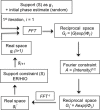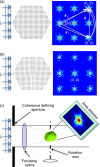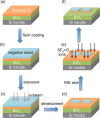Coherent X-ray diffraction imaging and characterization of strain in silicon-on-insulator nanostructures
- PMID: 24955950
- PMCID: PMC4282757
- DOI: 10.1002/adma.201304511
Coherent X-ray diffraction imaging and characterization of strain in silicon-on-insulator nanostructures
Abstract
Coherent X-ray diffraction imaging (CDI) has emerged in the last decade as a promising high resolution lens-less imaging approach for the characterization of various samples. It has made significant technical progress through developments in source, algorithm and imaging methodologies thus enabling important scientific breakthroughs in a broad range of disciplines. In this report, we will introduce the principles of forward scattering CDI and Bragg geometry CDI (BCDI), with an emphasis on the latter. BCDI exploits the ultra-high sensitivity of the diffraction pattern to the distortions of crystalline lattice. Its ability of imaging strain on the nanometer scale in three dimensions is highly novel. We will present the latest progress on the application of BCDI in investigating the strain relaxation behavior in nanoscale patterned strained silicon-on-insulator (sSOI) materials, aiming to understand and engineer strain for the design and implementation of new generation semiconductor devices.
Keywords: coherent X-ray diffraction Imaging; nanowire; silicon-on-Insulator; strain; ultrathin layer.
© 2014 The Authors. Published by WILEY-VCH Verlag GmbH & Co. KGaA, Weinheim.
Figures


 where a is the sample size and λ is the wavelength.
where a is the sample size and λ is the wavelength.











References
-
- Bartels RA, Paul A, Green H, Kapteyn HC, Murname MM, Backus S, Christov IP, Liu Yanwei, Attwood D, Jacobsen C. Science. 2002;297:376. - PubMed
-
- Takayama Y, Tai RZ, Hatano T, Miyhara T, Okamoto W, Kagoshima Y. J. Synchrotron Radiat. 1998;5:456. - PubMed
-
- van der Veen F, Pfeiffer F. J. Phys. Condens. Matter. 2004;16:5003.
-
- Vlieg E, de Vries SA, Alvarez J, Ferrer S. J. Synchrotron Radiat. 1997;4:210. - PubMed
-
- Bongaerts JHH, David C, Drakopoulos M, Zwanenburg MJ, Wegdam GH, Lackner T, Keymeulen H, vander Veen JF. J. Synchrotron Radiat. 2002;9:383.
Grants and funding
LinkOut - more resources
Full Text Sources
Other Literature Sources

